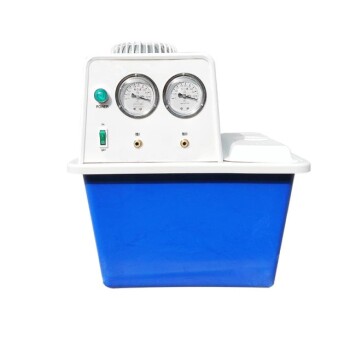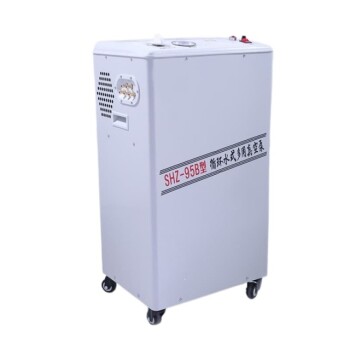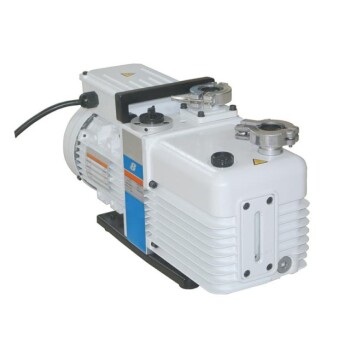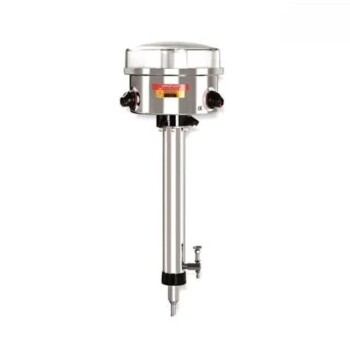A diffusion pump is a type of vacuum pump that operates by using a high-speed jet of vapor to direct gas molecules out of a chamber, creating a vacuum. However, it cannot function effectively at atmospheric pressure because it relies on a pre-existing vacuum to operate. At atmospheric pressure, the density of gas molecules is too high for the vapor jet to effectively direct them, rendering the pump inefficient. Additionally, the pump's working fluid would be exposed to atmospheric oxygen, leading to oxidation and degradation of the fluid. Therefore, diffusion pumps require a backing pump to reduce the pressure to a level where they can operate efficiently, typically in the range of 10^-2 to 10^-3 Torr.
Key Points Explained:

-
Operating Principle of a Diffusion Pump:
- Diffusion pumps use a high-speed jet of vapor (usually oil or mercury) to direct gas molecules out of the vacuum chamber.
- This process relies on the momentum transfer from the vapor jet to the gas molecules, which requires a low enough density of gas molecules to be effective.
-
Limitations at Atmospheric Pressure:
- At atmospheric pressure (760 Torr), the density of gas molecules is extremely high.
- The vapor jet cannot effectively direct such a large number of molecules, making the pump inefficient.
- The high density of gas molecules would also cause the vapor jet to scatter, further reducing the pump's effectiveness.
-
Risk of Oxidation and Degradation:
- The working fluid in a diffusion pump (typically oil or mercury) is sensitive to oxidation.
- At atmospheric pressure, the fluid would be exposed to oxygen, leading to oxidation and degradation of the fluid.
- This would not only reduce the pump's efficiency but also require frequent maintenance and replacement of the fluid.
-
Need for a Backing Pump:
- To operate effectively, a diffusion pump requires a pre-existing vacuum, typically in the range of 10^-2 to 10^-3 Torr.
- This initial vacuum is created using a backing pump, such as a rotary vane pump or a diaphragm pump.
- The backing pump reduces the pressure to a level where the diffusion pump can take over and achieve higher vacuum levels.
-
Typical Applications:
- Diffusion pumps are commonly used in applications requiring high vacuum levels, such as in semiconductor manufacturing, vacuum coating, and scientific research.
- These applications typically involve processes that require pressures well below atmospheric pressure, making diffusion pumps ideal for such environments.
-
Alternative Pumps for Atmospheric Pressure:
- For applications requiring operation at or near atmospheric pressure, other types of pumps, such as rotary vane pumps, diaphragm pumps, or scroll pumps, are more suitable.
- These pumps are designed to handle the high density of gas molecules at atmospheric pressure and do not rely on a vapor jet for operation.
In summary, a diffusion pump is not used at atmospheric pressure because its operating principle relies on a pre-existing vacuum to function effectively. The high density of gas molecules at atmospheric pressure would render the pump inefficient, and the exposure to oxygen would degrade the working fluid. Therefore, diffusion pumps are always used in conjunction with a backing pump to achieve the necessary initial vacuum levels.
Summary Table:
| Key Point | Explanation |
|---|---|
| Operating Principle | Uses a high-speed vapor jet to direct gas molecules, requiring low gas density. |
| Limitations at Atmospheric Pressure | High gas density makes the vapor jet ineffective and causes scattering. |
| Risk of Oxidation | Working fluid (oil/mercury) degrades when exposed to oxygen. |
| Need for a Backing Pump | Requires pre-existing vacuum (10^-2 to 10^-3 Torr) to operate efficiently. |
| Typical Applications | Used in semiconductor manufacturing, vacuum coating, and scientific research. |
| Alternative Pumps | Rotary vane, diaphragm, or scroll pumps are better for atmospheric pressure. |
Need help choosing the right vacuum pump for your application? Contact our experts today for personalized advice!







